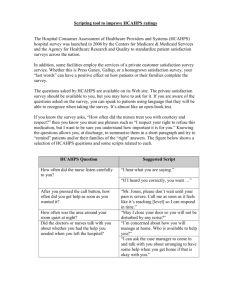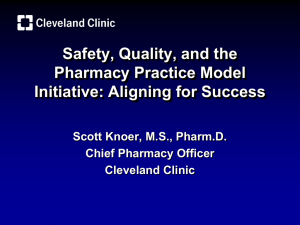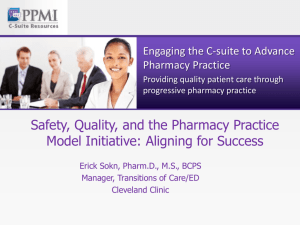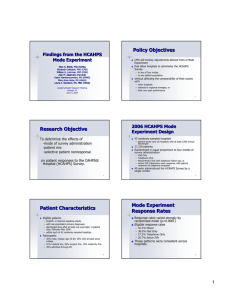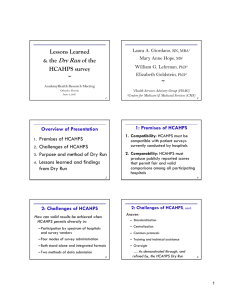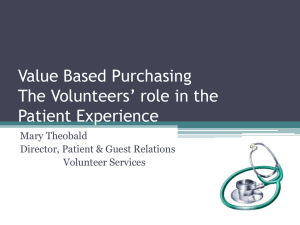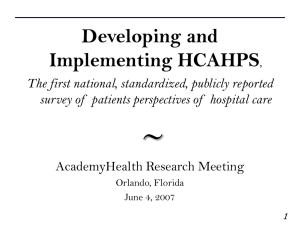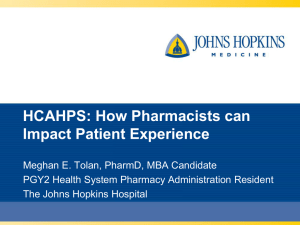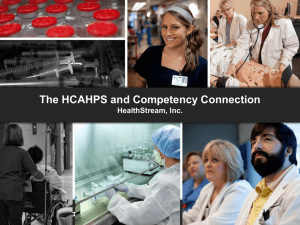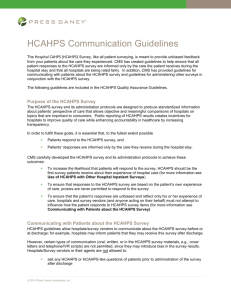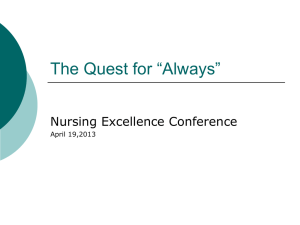Your Impact on HCAHPS
advertisement
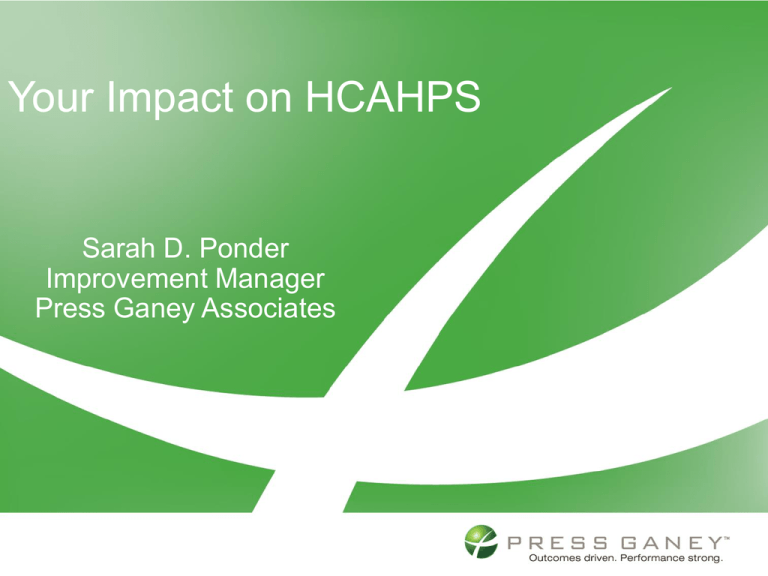
Your Impact on HCAHPS Sarah D. Ponder Improvement Manager Press Ganey Associates HCAHPS 101 What is CAHPS? Consumer Assessment of Healthcare Providers and Systems Produces comparable data for public reporting Creates incentive for organizations to improve Enhances public accountability and transparency Hospital CAHPS Home Health Care CAHPS Clinician and Group CAHPS … more to come! CAHPS provides an apples to apples metric for public reporting—additional measurement may be needed for ongoing quality improvement activities and monitoring. 3 Why is CAHPS ® Important? Consumers have access to the data Consumers relate more easily to CAHPS data than to clinical data Some use CAHPS data to choose hospitals ® ® CAHPS is in the public eye Media coverage Promotion by hospitals themselves ® Participation linked to reimbursement Will have volume, revenue, and reputation implications down the road 4 HCAHPS Survey 5 HCAHPS Survey Format Evaluative Questions About You Questions Global Rating Questions Screening Questions 6 Questions you Impact Hospital Environment During this hospital stay, how often were your room & bathroom kept clean? Never, sometimes, usually, always During this hospital stay, how often was the area around your room quiet at night? Never, sometimes, usually, always Overall Rating Using any number from 0 to 10, where 0 is the worst hospital possible and 10 is the best hospital possible, what number would you use to rate this hospital during your stay? 0-worst—10-best possible hospital Would you recommend this hospital to your friends & family? Definitely no, probably no, probably yes, definitely yes 7 General Survey Guidelines Patient Eligibility All payer types 18 years or older At least one overnight stay in the hospital (admit date & discharge date cannot be the same) All MS-DRGs except: Primary psychiatric diagnosis, discharged from rehab or from skilled nursing Alive at the time of discharge Not sent to patients with an international address Not sent to patients discharged to hospice or correctional facilities New: Not sent to patients discharged to nursing home or skilled nursing 8 Communication Guidelines Hospitals SHOULD Encourage response to the survey “It is permissible to notify the patient while in the hospital or at discharge that they may receive a survey after discharge.” Improve the patient experience Distribute the communication guidelines Hospitals SHOULD NOT Ask patients for a certain score Indicate that their goal is to receive a certain score New: Show the HCAHPS survey or cover letter to the patient prior to survey administration New: Mail pre-notification letter or postcards 9 Public Reporting HCAHPS Public Reporting Domains Communication with Doctors Communication with Nurses Responsiveness of Hospital Staff Pain Control Communication about Medicines Discharge Information Questions Cleanliness of Physical Environment Quiet of Physical Environment Overall Rating of Care Likelihood to Recommend 11 General Guidelines: Adjustments Data are adjusted based on the following: Patient Characteristics (“patient mix adjustment”) – Examples – Type of Service (Medical, Surgical, OB) – Self Reported Health – Age – Education – Language – Emergency room admission Mode of survey distribution (“mode adjustment”) Phone Mail Mixed mode- mail & phone Active Interactive Voice Response 12 Updated Public Reporting Schedule April 2011: Discharges from July 2009 – June 2010 July 2011: Discharges from October 2009 – September 2010 October 2011: Discharges from January 2010 – December 2010 January 2012: Discharges from April 2010 – March 2011 13 Tables- Distribution of Responses 14 Graphs - Percentage of “Always” Responses The yellow bars indicate the National & State averages. The blue bars indicate the averages for facilities selected. 15 State Reporting Programs Additional reporting programs through the states of California, Rhode Island, Minnesota, Ohio, Maryland, Maine 16 Value Based Purchasing Value-Based Purchasing Common Terminology: Pay for performance or Pay for quality Health Reform Updates Value Based Purchasing will start in fiscal 2013 Current hospital VBP program will transition from “Pay-for-Reporting” to “Pay-for Performance” Up to 2% of your Medicare reimbursement will be at stake Hospitals will lose reimbursement unless their performance is at benchmark levels Includes HCAHPS performance and Core Measures Will start at 1% and this will be ramped up to 2% by 2017 Who will be reimbursed for HCAHPS performance? Top performing healthcare providers Greatest improving healthcare providers 18 Hospital Value Based Purchasing - Measures Future Measures AHRQ patient safety indicators, inpatient quality indicators and composite measures Nursing sensitive care AMI, heart failure and pneumonia mortality rates 19 HCAHPS Measures Used In Value Based Purchasing Nurse Communication Doctor Communication Cleanliness and quietness Responsiveness of hospital staff Pain management Communication about medications Discharge information Overall hospital rating Copyright © 2011 Press Ganey Associates 20 Value Based Purchasing Model Hospitals will be awarded points toward their earn back of withheld DRG payments. Earn Achievement Points based on your performance on HCAHPS publicly reported measures. Earn Improvement Points based on improvement from the baseline period. The spread between the threshold to benchmark Baseline to 95th HCAHPS 8 Measures – 80 Possible Points 1 Consistency Score- 20 Possible Points 21 HCAHPS “Consistency” Points Up to 20 Points Based on Lowest Ranking HCAHPS Measure Points 20 10 10 20 30 • 40 50 60 70 Percentile Rank © MHA 2009 Copyright © 2011 Press Ganey Associates 22 80 90 99 Proposed Timeline Key Timeframes for VBP The “Baseline Period” discharges July 1, 2009 – March 31, 2010. The “Performance Period” discharges July 1, 2011 – March 31, 2012. Copyright © 2011 Press Ganey Associates 23 Moving from Measurement to Action: Improvement Strategies So where do we do focus? Patient Priorities Lowest Ranking Question Most Opportunity to Earn Money Back Create Performance Improvement Teams Around Each Publicly Reported Measure National HCAHPS data by Service Line 26 27 Step 1: Identify a Goal [S] Specific. Exactly what is it you wish to accomplish? [M] Measurable. Identify the means by which you will achieve each goal. How will you know when you have reached it? Keep in mind that you will always have more control over performance than you will over outcome so set performance goals whenever possible. [A] Action-oriented. Describe your goals using action verbs. What will you do (step by step) to reach your goal? [R] Realistic. Choose goals that are possible and achievable. Goals set too high will discourage while goals set too low will not challenge and motivate. [T] Timed. Determine deadlines for each of your goals. Deadlines can be flexible & adjusted as needed but deadlines help keep you focused and moving. 28 Step 2: Identify the Cause Look at patient comments for trends or patterns Conduct patient & employee focus groups Fishbone Diagram at a high level Patient Expectations “5 Why’s” What is causing area of poor performance? Root cause analysis Flowcharting What are the CTQs? 29 Cause- Solution Relationship Thinking backwards from the score itself What is the perception of patients? What do they experience? (long wait, conflicting information, being alone, in pain, etc.) How does it make them feel? (unvalued, confused, lack of trust, lonely, afraid, stressed, etc.) Causes don’t create a score, they create an environment in which a patient feels a certain way- that is what shapes how they evaluate care Determining cause is extremely important- it ensures you are efficient in your choice of strategy for improvement 30 Cause Solution Activity Make two columns: one with patient experiences & one with patient feelings Then make chart (below)- with your own ideas Then take this back to staff & get their input 31 Cause Solution Activity (cont.) Selecting a Course of Action: We have identified that we can impact the following causes: Because we can either: Modify the cause itself Modify how patients feel We are selecting the following viable practice to match the causes of the patients’ current experience: It should address the experience of patient (i.e. reduce wait time) or change the way a patient currently feels (i.e. reduce anxiety): 32 Step 3: Recommend a Solution Which causes are you trying to address? Which causes do you have control over? Will you modify a cause or shape perception? Does the selected solution address the causes or perceptions you have control over? Will the selected solution be visible to patients? Will it be big enough to change? Will it impact all patients? Is there anything you need to fix first, before you can implement this solution? 33 Room & Bathroom Kept Clean “During this hospital stay, how often were your room & bathroom kept clean? Ask patients when leaving the room if the room meets their cleanliness standards & if they would like anything else cleaned. Increase frequency of non-daily cleanings (i.e. washing walls, waxing the floor, etc.) Reinforce cleanliness by emptying waste baskets multiple times a day, offering to change sheets, etc. Make all staff accountable for the appearance, not just environmental services Include environmental services on unit cross functional teams 34 Quiet at Night “During this hospital stay how often was the area around your room quiet at night?” Modify equipment: Foam on trash cans, squeaky wheels on carts fixed, oil on doors, no overhead announcements, dim lights, phone ringers turned down Use a dosimeter to measure noise levels on unit & track for a period of time Work cross functionally with other departments to get feedback regarding building or equipment noise Provide patients with a welcome kit that talks about “Quiet hospitals help healing” that contains ear plugs, eye covers, & note that says: “one who has a good night’s rest awakes to a glorious morning” 35 Rate & Recommend this Hospital “Using any number from 0 to 10, where 0 is the worst hospital possible and 10 is the best hospital possible, what number would you use to rate this hospital during your stay?” “Would you recommend this hospital to your friends & family?” Empower all staff with power to “make it right” with patients Hire for attitude over aptitude, it is easier to teach skills than service Share data openly with all levels of the organization Focus on employee satisfaction, happy employees make for happy patients Use multiple outlets for patient feedback, especially creating a patient advisory council 36 Universal Viable Practices Rounding “Maintenance” Rounds Conducted a minimum of once per shift, environmental services staff visit each patient on the floor to make sure the cleanliness of the room meets their standards Introduction Rounds Each morning environmental services staff brings the morning paper to the patient with a sticker on it that says the staff member’s name & a contact number if at any point the room needs attention Appearance Rounds Once a day the building services director rounds on specific units & areas to get feedback from unit directors & managers on their current needs (i.e. light is out in room 203 or heater is not operational in conf room) Cross Functional Team Rounds A member of both the environmental services team & the building services team should sit on the patient satisfaction committees throughout the organization to help address related patient needs 38 Key Messages Key messages should be used when there is an important message all patients should receive Make sure a key message is: Staff that are going to use the key messages help to develop them Clear, short, and easy to understand Sounds natural and can be customized by staff Limit 4-5 key messages per staff member Examples: Greeting patients and families Entering and leaving patient rooms Communicating about actions that protect privacy/safety Informing patients of hospital services Patient rounds 39 Service Moments of Truth 40 Employ a Service Recovery Strategy Keep it simple & easy for everyone to remember Have one toolkit for every department A no questions asked policy should be enforced for toolkit usage Have tracking spreadsheet to look for service patterns Not all complaints warrant toolkit usage, most issues just require a sincere apology “6 A’s” Awareness Acknowledgement Apology Active Listening Action, Amendment Avoiding “H.E.A.R.T.” Philosophy Hear the patient Empathize with the patient Apologize to the patient Respond to the patient Thank the patient “H.E.A.T.” Philosophy Hear Empathize Apologize Take responsibility 41 “Relate” Philosophy Recognize concern Empathize Listen Apologize Take responsibility Explain what you are going to do Reward & Recognition Read patient comments to see if your staff members are mentioned by name Have a recognition program that allows staff members to nominate each other for going above & beyond Have a service hero of the month in your department Customize your recognition to the individual staff member In your one on one meetings with them ask them what their favorite food, restaurant, pasttime, etc. Celebrate birthdays & recognize anniversaries Celebrate your improvement with banners or trophies Schedule team outings or treats (i.e. pizza parties or ice cream socials) Hand written notes sent to their home 42 Data Sharing Have a bulletin board outside your department that contains: Patient satisfaction scores Patient comments that mention your department or staff Priority for the quarter or six month period Letters from patients Customer hero of the month Employee to employee recognition Educate new staff members on the survey process & your goals Create monthly electronic/printed dept. newsletters & dedicate a section to patient satisfaction data 43 Other General Practices “Director of First Impressions” Security, front desk staff, volunteers, etc. “Fresh as a Daisy” Color choices in patient rooms & hallways No flyers/posters taped to the walls or elevators Way-finding/signage Employee satisfaction focus Anticipate patient needs Separate areas on the units for physician/family consults 44 Step 4: Implement a Solution Two main phases: 1. Preparation a) Project team & roles b) Communication c) Development of training d) Preparing measurement e) Preparing accountability f) Prepare logistics 2. Execution a) Educate b) Roll-out: follow through on your plan 45 Steps 5 & 6: Monitor & Review Monitor: Measure Behavior Tracking Observation Self-Reporting Auditing Feedback Review: Did you meet your Goal? Yes Celebrate Increase Goal or Sustain No Why Not? 46 47 Thank you for attending!
